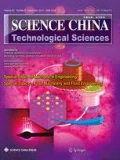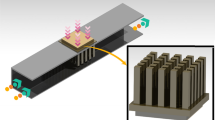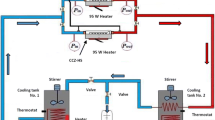Abstract
Silver nanofluids with three different volume fractions are prepared by a one-step chemical reduction method (Ultrasound-assisted Membrane Reaction (UAMR)). The convective heat transfer and friction characteristics of silver nanofluid in micro-pin fin heat sink are investigated experimentally. The results indicate that the pressure drops of nanofluids with different volume fractions have little difference. Compared to the base fluid (polyvinylpyrrolidone (PVP) solution), the pressure drop of nanofluids increases slightly at the same volume flow rate. When the flow rate is small, the increment is not obvious. The introduction of surfactant increases the fluid viscosity, so the pressure drops of nanofluids are larger than those of pure water, under the same flow rate. However, the maximum difference is no more than 10%. The volume fraction of silver nanoparticles significantly affects the convection heat transfer coefficient of micro-pin fin heat sink. The presence of nanoparticles improves significantly the heat transfer performance. However, high viscosity of the nanofluids hinders the heat transfer strengthening effect of nanofluids. In the present work, when the volume fraction of silver particles reaches to 0.012%, the thermal resistance of nanofluid gradually becomes lower than that of deionized water, which indicates the integrated heat transfer enhancement of nanofluids.
Similar content being viewed by others
References
Eastman J A, Choi S U S, Li S, et al. Anomalously increased effective thermal conductivities of ethylene glycol-based nanofluids containing copper nanoparticles. Appl Phys Lett, 2001, 78: 718–720
Peles Y, Kosar A, Mishra C, et al. Forced convective heat transfer across a pin fin micro heat sink. Int J Heat Mass Transf, 2005, 48: 3615–3627
Koşar A, Mishra C, Peles Y. Laminar flow across a bank of low aspect ratio micro pin fins. J Fluids Eng, 2005, 127: 419–426
Xia G D, Cui Z Z, Li Y J, et al. Flow resistance characteristics of de-ionized water flow through staggered diamond and circular micro pin fin arrays. In: AIP Conference Proceedings, Xi’an, 2010. 446–453
Patel H E, Das S K, Sundararajan T, et al. Thermal conductivities of naked and monolayer protected metal nanoparticle based nanofluids: Manifestation of anomalous enhancement and chemical effects. Appl Phys Lett, 2003, 83: 2931–2938
Zhu H, Lin Y, Yin Y. A novel one-step chemical method for preparation of copper nanofluids. J Colloid Interf Sci. 2004, 277: 100–103
Lee S, Choi S U S. Application of metallic nanoparticle suspensions in advanced cooling systems. International Mechanical Engineering Conference Session, Atlanta, 1996
Li Q, Xuan Y M. Convective heat transfer and flow characteristics of Cu-water nanofluid. Sci China Ser E-Tech Sci, 2002, 54(4): 408–416
Wen D, Ding Y. Experimental investigation into convective heat transfer of nanofluids at the entrance region under laminar flow conditions. Int J Heat Mass Transf, 2004, 47: 5181–5188
Jung J Y, Oh H S, Kwak H Y. Forced convective heat transfer of nanofluids in microchannels. Int J Heat Mass Transf, 2009, 52: 466–472
Wu X Y, Wu H Y, Qu J. Flow and heat transfer characteristics of nanofluids in silicon chip microchannels. J Chem Indust Eng, 2008, 59: 2181–2187
Wang Z Y, He H, Dai H X, et al. Preparation of Ag nanoparticles by Ultrasound-assisted Membrane Reaction. Chem J Chinese Univ, 2007, 28: 1756–1758
Xuan Y M, Li Q. Heat transfer enhancement of nanofluids. Int J Heat Fluid Flow, 2000, 21: 58–64
Chein R, Huang G. Analysis of microchannel heat sink performance using nanofluids. Appl Therm Eng, 2005, 25: 3104–3114
Li J, Kleinstreuer C. Thermal performance of nanofluid flow in microchannels. Int J Heat Fluid Flow, 2008, 29: 1221–1232
Das S K, Putra N, Thiesen P, et al. Temperature dependence of thermal conductivity enhancement for nanofluids. J Heat Transf, 2003, 125: 567–576
Pak B C, Choi Y I. Hydrodynamic and heat transfer study of dispersed fluids with submicron metallic oxide particles. Exp Heat Transf, 1998, 11: 151–170
Author information
Authors and Affiliations
Corresponding author
Rights and permissions
About this article
Cite this article
Zhou, M., Xia, G., Chai, L. et al. Analysis of flow and heat transfer characteristics of micro-pin fin heat sink using silver nanofluids. Sci. China Technol. Sci. 55, 155–162 (2012). https://doi.org/10.1007/s11431-011-4596-5
Received:
Accepted:
Published:
Issue Date:
DOI: https://doi.org/10.1007/s11431-011-4596-5




